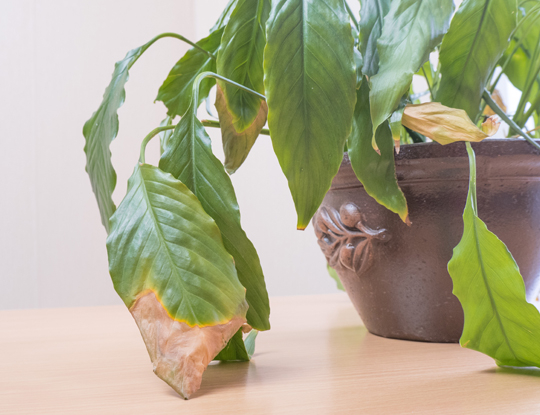by Laurel Thompson

Plant parenting isn’t always easy. Despite our best efforts, leaves sometimes dry up, turn yellow, or fall right off, and it takes some investigating to figure out why. Here are some common houseplant problems and how to solve them:
YELLOW LEAVES & DROPPING LEAVES
Leaves can turn yellow for a number of reasons, including overwatering/underwatering, certain pests, or old age. Yellow leaves won’t turn green again, so always remove them to encourage new growth.
If the leaves are turning yellowish-brown, crisping up, or becoming wrinkly, odds are the plant has gone too dry and will need a good soak (succulents and cacti need water too!). However, if the plant was watered too frequently, the leaves may turn yellow and become mushy. Pull the plant out of its pot and trim off any rotten roots, then pot it in fresh soil and allow it to dry out before watering.
Yellowing leaves can also be a sign of spider mites or scale insects, especially if the leaves drop rapidly and are covered in sticky sap. Look for fine webbing and tiny moving dots (spider mites) in the curvature of the leaves, or small brown circles (scale) along the center vein. Trim off any infested leaves, douse the plant in neem oil, and let it drip dry. Repeat weekly until the pests are gone.
FLIES & ROOT ROT
Fungus gnats are easily recognizable, resembling black fruit flies crawling along the soil. Fungus gnats indicate overwatering as they feed on rotting roots, so the first step is to remove the plant from its pot. Shake off the old soil, trim off any root rot, and repot the plant in fresh, dry soil. Spread Mosquito Bits® on the soil surface and water to kill the remaining larvae, then hang sticky traps to capture any adults before they burrow back into the soil.
If the flies are white, odds are they’re whiteflies (which can also cause yellow leaves). Sticky traps will work, though these pests sit on the undersides of leaves and only move if disturbed. White, powdery clusters that don’t fly are likely another insect called mealybug, which can be removed with an isopropyl alcohol Q-tip followed by a generous coat of insecticidal soap.
LEAF SPOTS & BROWN TIPS
Spots on the leaves are another issue, and it can be difficult to discern between fungal rings and sunburn. Fungal infections generally appear as a brownish blob surrounded by a yellow ring, or small orange spots called rust. Trim leaves with questionable spots, spray the plant with fungicide, and disinfect pruners between cuts to avoid spreading the spores between plants.
Sunburn often looks similar to fungal spots, though the damage is usually larger, less round, and lacks a yellow halo. Most houseplants prefer bright indirect light, so avoid direct sunlight to prevent scorched leaves.
If the leaf edges turn brown, that can indicate a sensitivity to tap water or a lack of humidity. Some plants are more sensitive to tap water than others (like calatheas and dracaenas), so give them distilled water, rain water, or spring water instead. Use a humidifier or set the plant on a pebble tray so the water can evaporate up onto the leaves.
Originally published on February 2nd, 2024.
